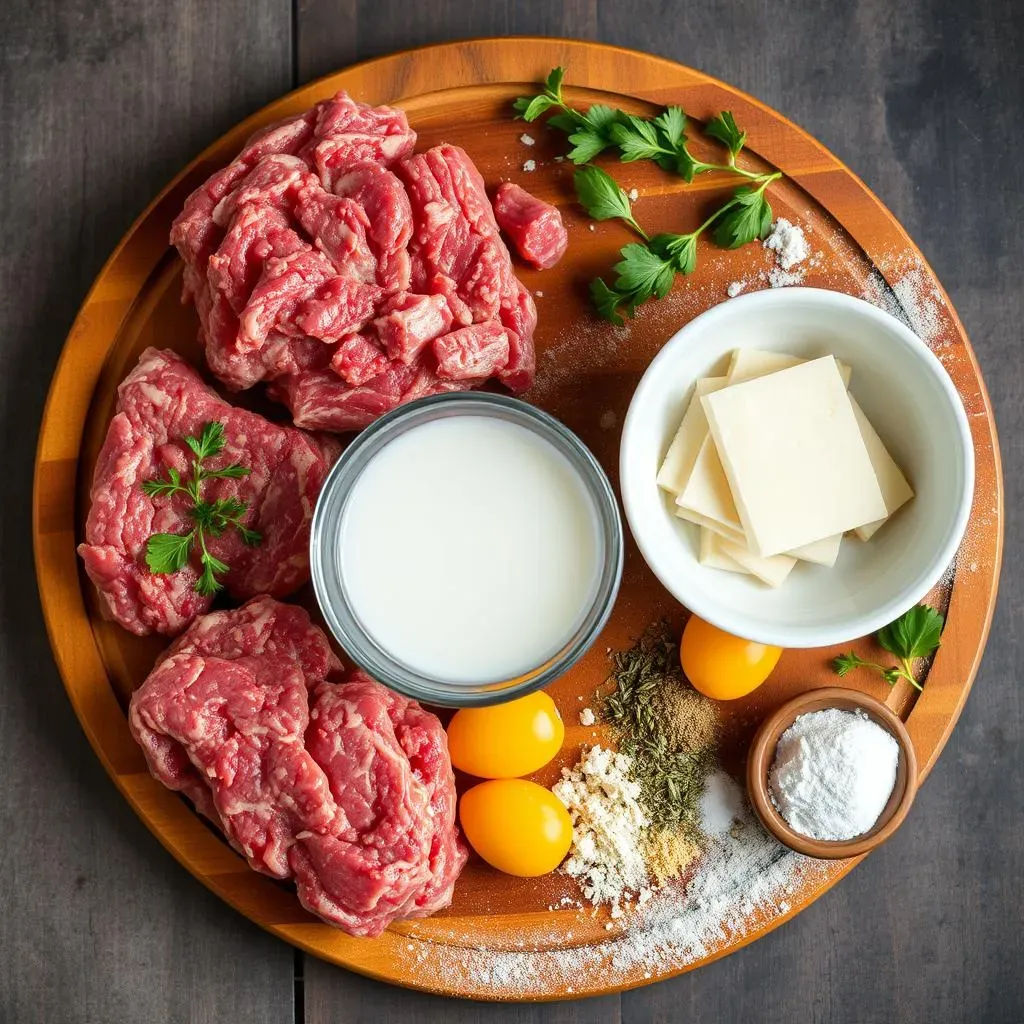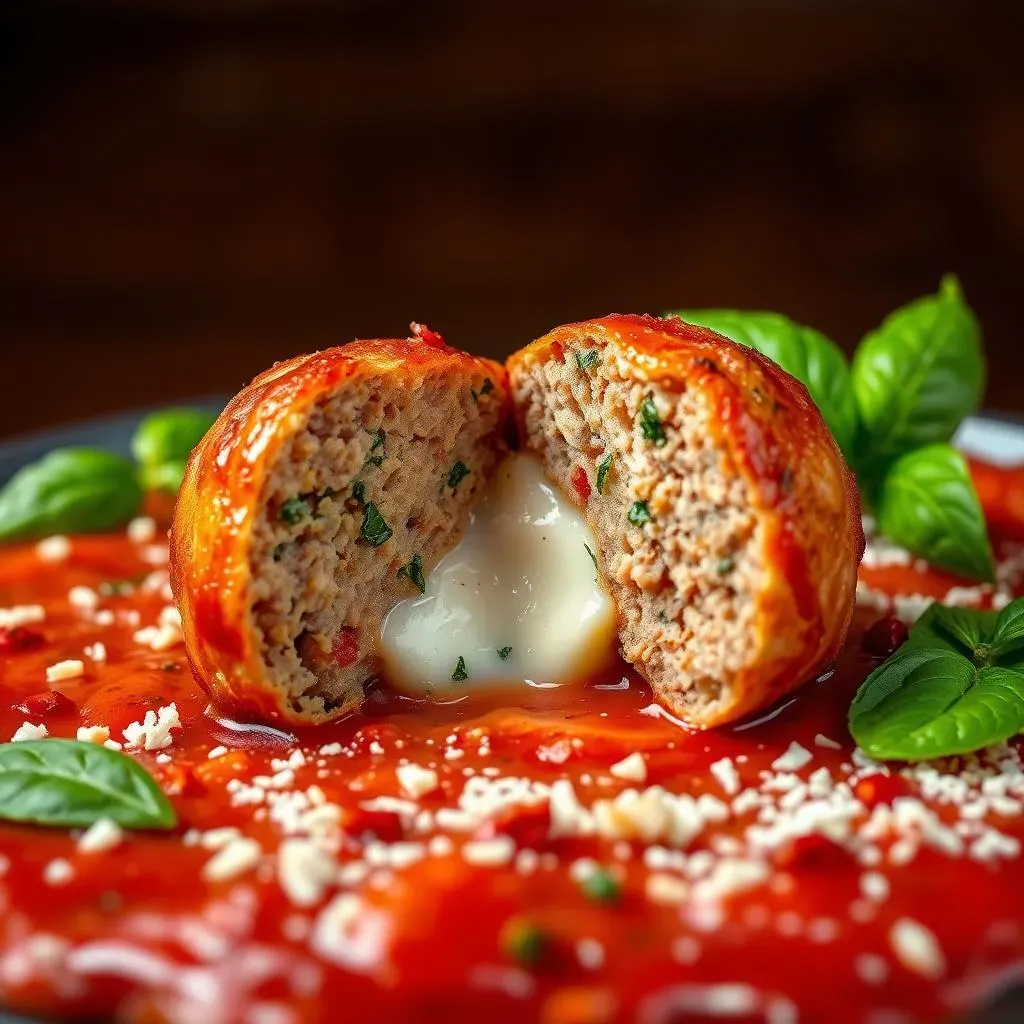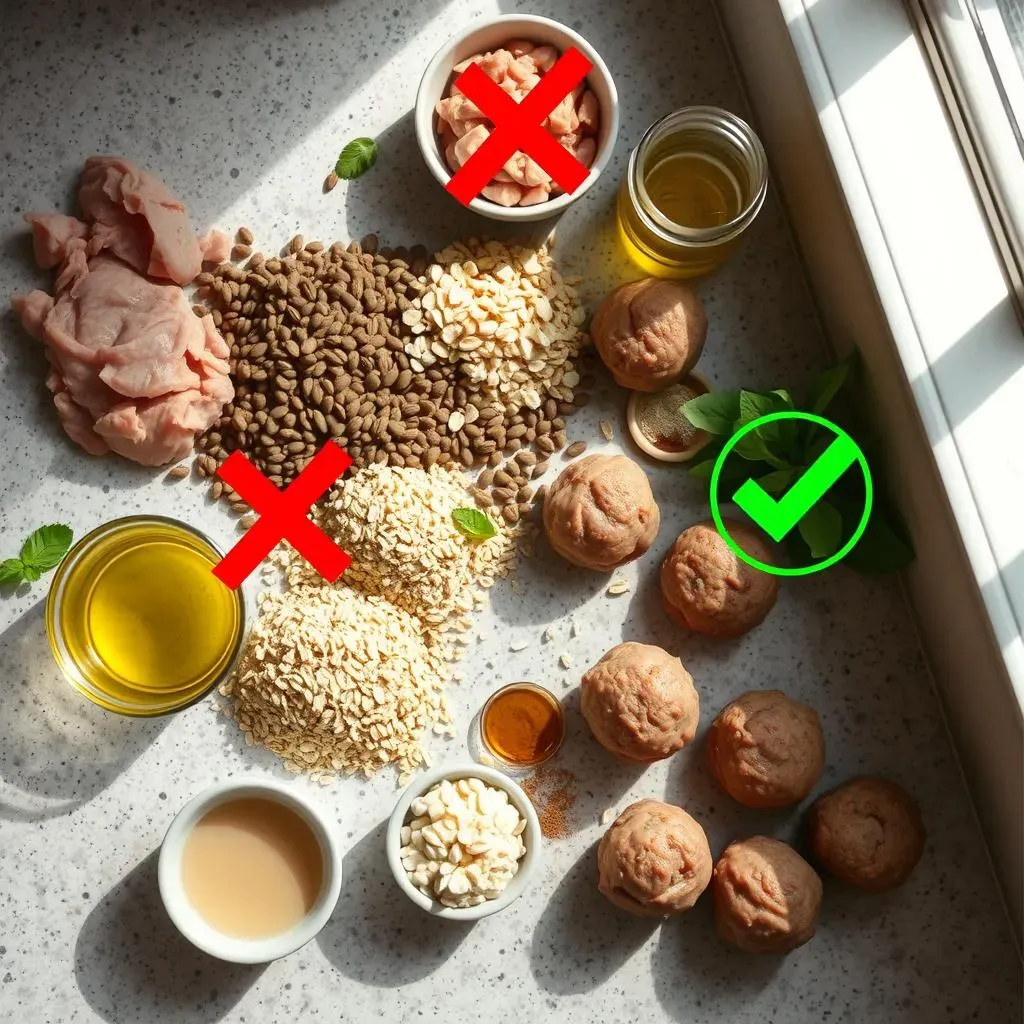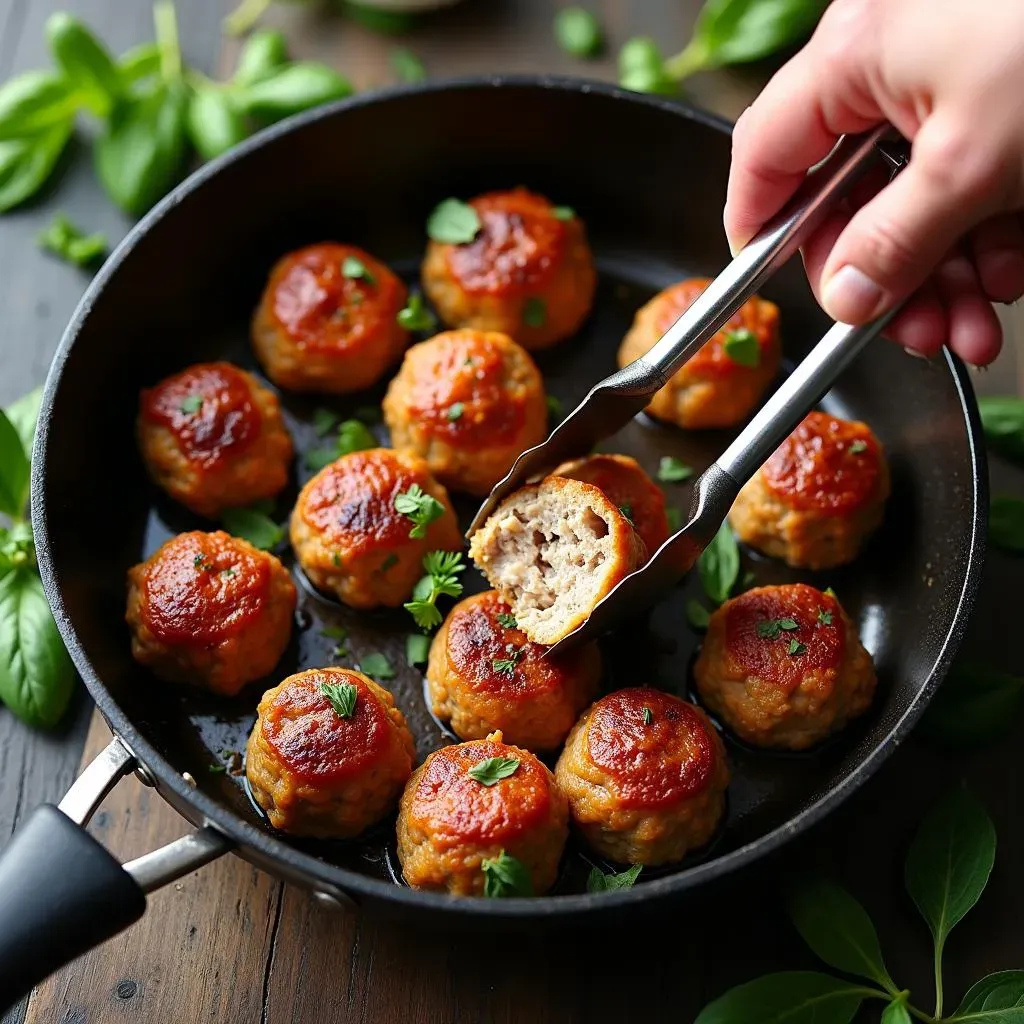Table of Contents
Craving the ultimate comfort food? It all starts with the right meatball recipe ingredients. Forget dry, bland spheres – we're diving deep into the world of flavorful, juicy meatballs that will have everyone begging for seconds. This isn't just about tossing ground meat and breadcrumbs together; it's about understanding how each ingredient contributes to the final masterpiece. From selecting the perfect blend of meats to choosing the herbs and spices that will make your meatballs sing, we'll cover it all. We'll explore essential ingredients, creative additions, and even substitutions for those times when your pantry is running low. So, grab your apron, and get ready to unlock the secrets to meatball perfection. By the end of this article, you'll be equipped with the knowledge to create meatballs that are the star of any dish, whether you're serving them with spaghetti, in a sub, or as a delicious appetizer.
Essential Meatball Recipe Ingredients: The Foundation of Flavor

Essential Meatball Recipe Ingredients: The Foundation of Flavor
The Perfect Meat Blend
Let's talk meat, the heart and soul of any meatball. While you can certainly use just ground beef, the real magic happens when you combine it with other meats. Ground beef provides that classic, hearty flavor, but adding ground pork brings moisture and a subtle sweetness. For an even more decadent meatball, consider a touch of ground veal. The combination creates a depth of flavor that's simply irresistible. Aim for a ratio of roughly 1:1:1 if you're using all three, or adjust to your liking. Don't be afraid to experiment! Some people swear by a higher percentage of pork for extra juiciness.
When choosing your ground meat, pay attention to the fat content. Lean ground beef (around 80/20) is a good starting point, but a little fat is your friend here. It helps keep the meatballs moist and tender during cooking. If you're using leaner meats, you might want to add a touch of olive oil or even some finely grated Parmesan cheese to compensate. Remember, dry meatballs are a tragedy, and the right meat blend is your first line of defense.
Binding Agents and Breadcrumbs
Now that we've got the meat sorted, let's talk about how to hold it all together. Eggs are your trusty binding agent, helping to create a cohesive mixture that won't fall apart during cooking. Use one or two eggs per pound of meat, depending on the size of your eggs and the consistency of your mixture. But eggs alone aren't enough. You also need breadcrumbs.
Forget the pre-packaged stuff – fresh breadcrumbs are the way to go. They add a lightness and tenderness that you just can't get from dried crumbs. Simply pulse some crusty bread in a food processor until you have coarse crumbs. You can even use leftover bread, which is a great way to reduce waste. Soak the breadcrumbs in milk or broth before adding them to the meat mixture. This creates a panade, which helps to keep the meatballs moist and prevents them from becoming tough. Trust me, this step is a game-changer.
Ingredient | Purpose | Tips |
|---|---|---|
Ground Beef | Base flavor and texture | 80/20 blend is a good starting point |
Ground Pork | Moisture and sweetness | Adds richness and prevents dryness |
Eggs | Binding agent | Use 1-2 per pound of meat |
Fresh Breadcrumbs | Lightness and tenderness | Soak in milk or broth for best results |
Beyond the Basics: Exploring Unique Meatball Recipe Ingredients

Beyond the Basics: Exploring Unique Meatball Recipe Ingredients
Cheese, Glorious Cheese
Ready to take your meatballs to the next level? Let's talk cheese. Adding cheese directly to your meatball mixture is a surefire way to boost flavor and add a creamy, melty surprise inside. Parmesan is a classic choice, offering a salty, nutty flavor that complements the meat beautifully. But don't stop there! Try adding a handful of shredded mozzarella for extra gooeyness, or a sprinkle of Pecorino Romano for a sharper, more intense flavor. For a truly decadent experience, consider incorporating small cubes of provolone or even a dollop of ricotta cheese into the center of each meatball before cooking. Just be careful not to overmix the cheese, as it can make the meatballs tough.
The type of cheese you choose will depend on the overall flavor profile you're aiming for. For a traditional Italian meatball, Parmesan or Pecorino Romano are excellent choices. If you're looking for something a bit more adventurous, try adding some crumbled feta cheese or even a touch of blue cheese for a pungent, savory kick. Remember to adjust the amount of salt in your recipe accordingly, as some cheeses can be quite salty. Experiment and have fun – the possibilities are endless!
Cheese Type | Flavor Profile | Best Uses |
|---|---|---|
Parmesan | Salty, nutty, umami | Classic Italian meatballs, pairs well with beef and pork |
Mozzarella | Mild, creamy, melty | Adds gooeyness, great for kids |
Pecorino Romano | Sharp, salty, intense | Adds a bold flavor, use sparingly |
Ricotta | Mild, creamy, slightly sweet | Adds moisture and tenderness, use in moderation |
Herb and Spice Infusion
Beyond salt and pepper, the right herbs and spices can transform your meatballs from ordinary to extraordinary. Fresh herbs are always a great choice, adding a vibrant aroma and flavor that dried herbs simply can't match. Italian parsley is a classic, but don't be afraid to experiment with other herbs like basil, oregano, thyme, or even a touch of rosemary. Finely chop the herbs before adding them to the meat mixture, and be generous – you want their flavor to really shine through.
Spices can also add depth and complexity to your meatballs. Garlic is a must, of course, but consider adding a pinch of red pepper flakes for a touch of heat, or a dash of smoked paprika for a smoky flavor. Ground fennel seed is another great addition, especially if you're using pork in your meatball mixture. It adds a subtle licorice flavor that complements the pork beautifully. And don't forget about dried Italian seasoning, which is a convenient way to add a blend of classic Italian herbs and spices to your meatballs. Just be sure to use a good quality blend, as some can be bland or stale.
Meatball Recipe Ingredients Substitutions: Adapting to Your Pantry

Meatball Recipe Ingredients Substitutions: Adapting to Your Pantry
Meat Alternatives: When You're Out of Beef (or Pork, or Veal!)
so you're all set to make meatballs, but you open the fridge and... disaster! You're missing one of the key meats. Don't panic! Ingredient substitutions are your friend. Ground turkey or chicken can absolutely step in for beef, pork, or veal. Just keep in mind that they're leaner, so you might want to add a tablespoon or two of olive oil to the meat mixture to keep things moist. You could also try using ground lamb for a richer, more distinct flavor. It's a little more assertive than beef, so it's best used in smaller quantities, maybe as a partial substitute. And for a plant-based option, try using lentils or a pre-made plant-based ground "meat." Just adjust the seasonings accordingly to complement the different flavor profiles.
The key to successful meat substitutions is to balance the flavors and textures. If you're using a leaner meat, consider adding some finely grated Parmesan cheese or even a bit of cream cheese to boost the richness and moisture. And don't be afraid to adjust the cooking time – leaner meats tend to cook faster, so keep a close eye on them to prevent them from drying out. With a little creativity, you can create delicious meatballs with whatever meat (or meat alternative) you have on hand.
Substitution | Meat Replaced | Notes |
|---|---|---|
Ground Turkey/Chicken | Beef, Pork, Veal | Leaner, add olive oil for moisture |
Ground Lamb | Beef | Richer flavor, use in moderation |
Lentils/Plant-Based Ground | Any meat | Adjust seasonings accordingly |
Breadcrumb Swaps: No Bread, No Problem!
Uh oh, no bread for breadcrumbs? It happens! Thankfully, there are plenty of substitutes you can use. Crushed crackers, like Ritz or saltines, work surprisingly well. They add a slightly different flavor, but they'll still bind the meat together nicely. You can also use rolled oats (pulse them in a food processor first to break them down), or even cooked rice or quinoa. If you're gluten-free, almond flour or gluten-free breadcrumbs are excellent options. Just be sure to adjust the amount of liquid in your recipe accordingly, as some of these substitutes absorb more moisture than breadcrumbs.
The goal is to find a substitute that will bind the meat together without adding too much flavor of its own. Crushed crackers tend to be a bit saltier, so you might want to reduce the amount of salt you add to the meat mixture. Rolled oats add a slightly nutty flavor, which can be quite pleasant. And cooked rice or quinoa add a bit of extra moisture, which can be helpful if you're using leaner meats. No matter what you choose, make sure to soak the substitute in milk or broth before adding it to the meat mixture. This will help to soften it and prevent it from drying out the meatballs.
Tips and Tricks: Mastering Meatball Recipe Ingredients for the Best Results

Tips and Tricks: Mastering Meatball Recipe Ingredients for the Best Results
Don't Overmix, Don't Overpack
Alright, you've got all your meatball recipe ingredients prepped and ready to go. Now, here's a crucial tip: don't overmix! Overmixing develops the gluten in the meat, resulting in tough, dense meatballs. Mix just until everything is combined. I know it's tempting to really get in there and work the mixture, but resist! Gently incorporate the ingredients, and stop as soon as they're evenly distributed. The same goes for packing the meatballs. Don't squeeze them too tightly. Roll them gently between your palms to form loose, round shapes. This allows for even cooking and prevents them from becoming dense and rubbery.
Think of it like this: you're not trying to make hockey pucks, you're trying to make tender, juicy morsels of deliciousness. The more you handle the meat, the tougher it will become. So, be gentle, be patient, and let the ingredients do their thing. A light touch is the key to meatball success. Also, wet your hands with cold water before rolling the meatballs. This prevents the meat from sticking to your hands and makes the process much easier. Trust me, your meatballs will thank you for it.
The Secret to Even Cooking
you've got your perfectly formed meatballs. Now, how do you ensure they cook evenly? The key is to start with a hot pan and don't overcrowd it. If you're pan-frying, use a large skillet and work in batches. Overcrowding the pan lowers the temperature and causes the meatballs to steam instead of brown. You want that beautiful, golden-brown crust on all sides. If you're baking, use a rimmed baking sheet lined with parchment paper. This prevents the meatballs from sticking and makes cleanup a breeze. And be sure to space them out evenly on the sheet. Again, overcrowding will lead to uneven cooking.
Another trick is to use a thermometer to check for doneness. Insert the thermometer into the center of a meatball, and make sure it reaches an internal temperature of 160°F (71°C). This ensures that the meat is cooked through and safe to eat. If you're making a large batch of meatballs, you can also do a test run with one or two meatballs to make sure your cooking time and temperature are correct. It's better to sacrifice a couple of meatballs than to ruin the whole batch. Remember, patience is a virtue when it comes to cooking meatballs. Don't rush the process, and you'll be rewarded with perfectly cooked, delicious meatballs every time.
Tip | Description | Why it Works |
|---|---|---|
Don't Overmix | Mix gently until just combined | Prevents tough meatballs |
Don't Overpack | Roll loosely between palms | Allows for even cooking |
Hot Pan, Don't Overcrowd | Cook in batches in a large skillet | Ensures browning, not steaming |
Use a Thermometer | Cook to 160°F (71°C) | Ensures meat is cooked through |
Conclusion: Mastering Meatball Recipe Ingredients for Culinary Success
From selecting the ideal blend of ground meats to experimenting with aromatic herbs and spices, understanding the role of each meatball recipe ingredient is key to achieving meatball mastery. Whether you stick to the classics or venture into creative variations, the knowledge you've gained here will empower you to create consistently delicious and satisfying meatballs. So, go forth, experiment with confidence, and enjoy the delightful results of your newfound meatball prowess. Your next batch of meatballs is sure to be a crowd-pleaser!